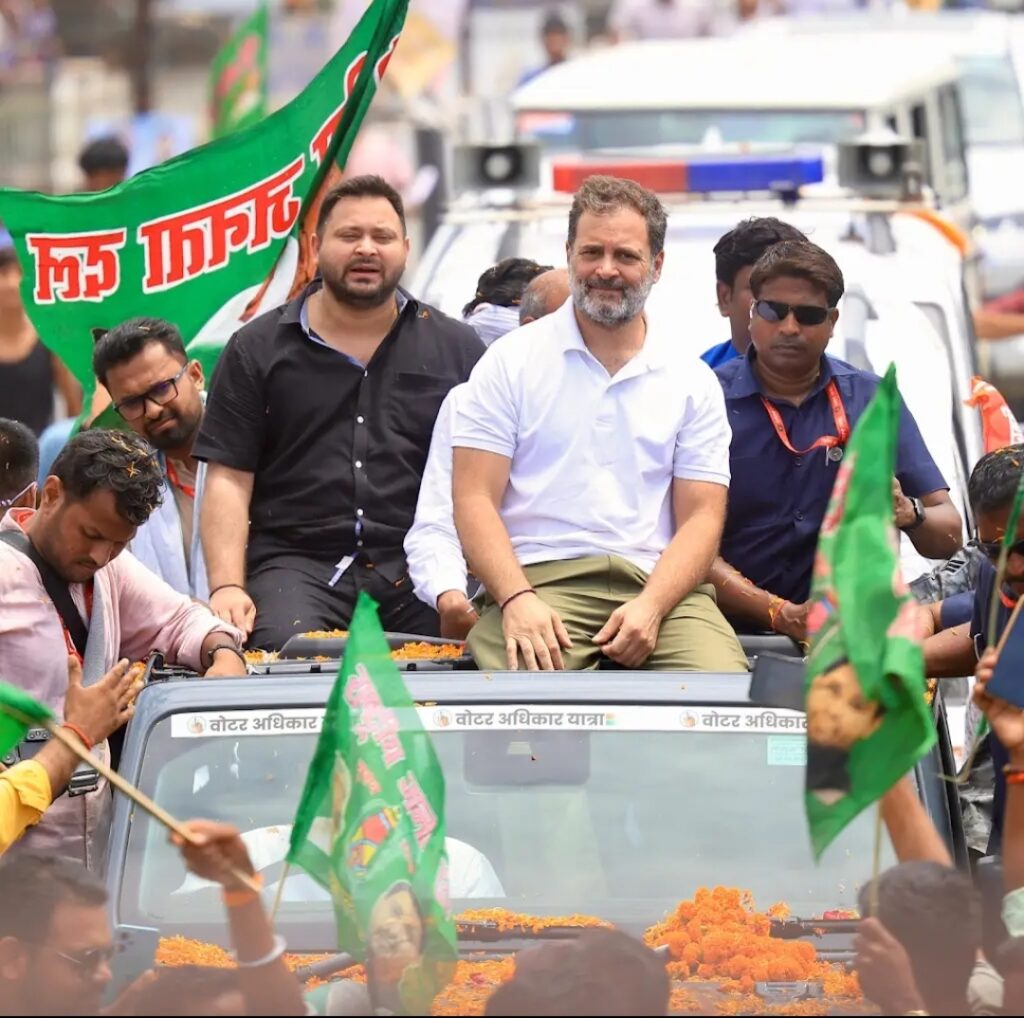
Voter Adhikar Yatra: Bihar’s March Against ‘Vote Theft’ Ignites Electoral Firestorm
As the sun set on the iconic Gandhi Maidan on September 1, a sea of red, green, and white flags fluttered in unison, marking the triumphant culmination of the Voter Adhikar Yatra. Led by Congress leader Rahul Gandhi and Rashtriya Janata Dal (RJD) scion Tejashwi Yadav, alongside other INDIA alliance stalwarts, the 16-day odyssey traversed 1,300 kilometers across 25 districts and over 110 assembly constituencies. What began as a protest against alleged voter deletions has morphed into a potent symbol of resistance, challenging the Nitish Kumar-led NDA government and reshaping Bihar’s political landscape ahead of the November 2025 assembly elections. But has it truly empowered the disenfranchised, unified the opposition, and altered the state’s electoral calculus?
This analysis delves into the yatra’s multifaceted impact on the forthcoming assembly election in Bihar as also on the national politics.
The Genesis: From Voter Deletions to a Mass Movement
The yatra’s roots lie in the controversy surrounding the Election Commission of India’s (ECI) Special Intensive Revision (SIR) of electoral rolls, initiated in Bihar to update voter lists. Opposition leaders allege that this exercise has led to the deletion of over 65 lakh names, predominantly from marginalized communities—Dalits, Other Backward Classes (OBCs), Extremely Backward Classes (EBCs), and minorities—who form the backbone of anti-BJP voting blocs.
Rahul Gandhi, launching the yatra from Sasaram on August 17, framed it as a battle to protect the “poor man’s only power—the vote,” accusing the BJP, RSS, and ECI of orchestrating “vote chori” (vote theft).
The SIR process, defended by the ECI as a routine cleanup to remove duplicates and deceased voters, has been criticized for its opacity and timing, just months before polls. Tejashwi Yadav amplified the outrage by claiming his own name was initially omitted, though the ECI clarified it was a misunderstanding.
The Supreme Court’s intervention, allowing Aadhaar cards as proof for voter reinstatement, came amid the yatra’s momentum, underscoring its role in forcing institutional responses. Flood-affected regions, where displaced villagers struggle to access booth-level officers (BLOs), have seen heightened panic, with fears extending beyond voting rights to welfare benefits like ration cards.
Crowds swelled spontaneously, with daily gatherings exceeding 1 lakh in places like Munger and Muzaffarpur, far surpassing organized rallies.
Local journalists report that the yatra’s emotional appeal—framing voter deletions as an assault on democracy—has penetrated rural households, turning abstract grievances into a rallying cry.
Achievements for Disenfranchised Voters: Awareness Over Immediate Relief
For the millions allegedly stripped of their voting rights, the yatra’s primary achievement has been amplifying their voices. Stories of families discovering deletions only upon checking lists have flooded social media and local forums. 10 The opposition claims these removals disproportionately affect non-BJP voters, with Rahul Gandhi highlighting data from a Karnataka constituency to illustrate nationwide patterns.
In Bihar, the ECI admits to removing 65 lakh names but insists 98% of voters have re-enrolled, dismissing allegations as misinformation.
Practically, the yatra facilitated on-ground assistance: volunteers helped file Form 6 for inclusions and Form 7 for objections, leading to thousands of restorations in districts like Katihar and Darbhanga. However, challenges persist—floods in areas like Bhojpur have displaced communities, making physical verifications arduous.
Critics argue the yatra’s impact is more symbolic than substantive; while it pressured the ECI to extend deadlines and accept Aadhaar, systemic flaws remain unaddressed. Nonetheless, it empowered voters like Prince Kumar, who publicly shared his family’s deletion, fostering a sense of agency amid despair.
By transforming personal grievances into a collective movement, the yatra has arguably prevented further erasures, with opposition leaders vowing to monitor the final rolls.
Boost for the INDIA Bloc: Unity and Momentum Redefined
The yatra has been a masterstroke for the INDIA alliance, forging unprecedented unity in a fragmented opposition landscape. Rahul Gandhi’s constant presence, flanked by Tejashwi Yadav, CPI(ML)’s Dipankar Bhattacharya, and Vikassheel Insaan Party’s Mukesh Sahani, projected a cohesive front. Guest appearances by Tamil Nadu CM MK Stalin, Samajwadi Party’s Akhilesh Yadav, Jharkhand CM Hemant Soren, and others elevated it to a national crusade, drawing parallels to historical movements like the Champaran Satyagraha.
Internally, it bolstered Congress’s bargaining power within the alliance. Analysts note Rahul’s dominance during the yatra has positioned Congress favourably for seat-sharing negotiations, potentially claiming more than its 2015 tally of 27 seats. For RJD, Tejashwi’s aggressive stance on “vote chor, gaddi chhod” (vote thieves, vacate the throne) has re-energized his Yadav-Muslim base, though some observers suggest he appears overshadowed by Rahul.
The yatra’s success—marked by massive, organic crowds—has boosted morale, with Congress leaders like Randeep Surjewala calling it a “new revolution.” Social media posts and semantic searches reveal widespread enthusiasm, with phrases like “game changer” trending among supporters.
Shadows Over Nitish Kumar’s Future: Erosion of a Flip-Flop Legacy
Nitish Kumar, Bihar’s longest-serving CM and JD(U) leader, faces his toughest test yet. The yatra relentlessly targeted him, portraying the SIR as a BJP-orchestrated ploy under his watch to manipulate polls. 8 Rahul and Tejashwi lambasted his alliance-hopping, dubbing him a “paltu ram” (flip-flopper), while highlighting unfulfilled promises like special status for Bihar and job creation.
The yatra exposed anti-incumbency: issues like unemployment, migration, and floods amplified voter deletions, eroding Nitish’s EBC and women voter base.
NDA counters, like minister Ashok Choudhary’s taunt that improved roads enabled the yatra, fell flat amid chants of “vote chor.” Recent schemes—pension hikes, free electricity up to 125 units, and women’s loans—aim to mitigate damage, but polls suggest NDA’s lead narrowing from 46% to closer parity with INDIA.
Nitish’s future hinges on BJP support, but a poor showing could force retirement or another switch, destabilizing NDA.
Implications for the 2025 Assembly Elections: A Shift in Momentum
With Bihar’s 243-seat assembly polls looming, the yatra could tilt the scales. The emotional resonance of “vote theft” transcends castes, uniting anti-NDA voters and potentially boosting turnout among marginalized groups. Opposition unity, absent in 2020 when NDA scraped through with 125 seats, now appears solidified, with INDIA eyeing 140+.
However, NDA’s caste arithmetic—BJP’s upper castes, JD(U)’s EBCs, and allies like HAM—remains formidable. Prashant Kishor’s Jan Suraaj could split votes, inadvertently aiding NDA, though his padyatra has been overshadowed. If the yatra sustains momentum, it might replicate Congress’s 2024 Lok Sabha gains in Bihar (from 1 to 3 seats), pushing INDIA toward a majority.
A Game Changer for Bihar Politics?
The Verdict
Yes, the Voter Adhikar Yatra has the potential to be a pivotal moment. By framing voter rights as a constitutional battle, it has galvanized the masses, exposed ECI vulnerabilities, and revitalized the opposition. Unlike past yatras focused on development, this one’s emotional core—protecting democracy—has drawn spontaneous support, echoing Bihar’s history of people-powered change. Yet, its long-term impact depends on translating crowds into votes; scepticism lingers, with some voters unaware or unmoved.
In a state where politics is as fluid as the Ganges, the yatra has injected volatility. For voters, it’s a beacon of hope; for INDIA, a launchpad; for Nitish, a storm cloud. As Bihar heads to polls, one thing is clear: the fight for “one person, one vote” has redefined the battleground.
Hasnain Naqvi is a former member of the history faculty at St. Xavier’s College, Mumbai





